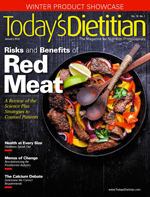 January 2016 Issue
January 2016 Issue
Ask the Expert: Popular Fad Diets for 2016
By Toby Amidor, MS, RD, CDN
Today's Dietitian
Vol. 18 No. 1 P. 8
Q: What are the names of some of the fad diets in 2016 that clients may ask dietitians about?
A: One of the most popular New Year's resolutions is to lose weight. As such, once January 1 comes around, the popularity of fad diets skyrocket. It's important for nutrition professionals to stay abreast of the latest diet trends. Here are several you may be hearing about from clients and patients.
The Military Diet
The Military Diet promises a weight loss of up to 10 lbs without strenuous exercise or medications. According to its creators, the purpose of this plan is for "emergency" situations, such as an upcoming wedding. The low-calorie meal plan, which dieters follow three days of the week, is provided by the Military Diet website (themilitarydiet.com). The three days consist of a combination of three meals per day and "chemically compatible" food to help jumpstart weight loss. For example, breakfast may include one egg, one slice of toast, and one banana.
Allowable foods include apples, bananas, meat, peanut butter, eggs, green beans, and vanilla ice cream, along with water, coffee, and Stevia (the only allowable sweetener). On the four off-days, any foods are allowed as long as total calories are 1,500 or less. The dieter can continue this three days on and four days off pattern if they choose.
This plan isn't scientifically sound and doesn't provide specific guidelines. The unexplained selection of foods, especially if followed over a longer period of time, leaves room for inadequate nutrient consumption, which should be the primary concern of the practitioner.
The HMR Diet
More than 30 years ago, behavioral psychologist Lawrence Stifler developed the Health Management Resources (HMR) program. The diet claims that three times as much weight is lost and kept off using low-calorie shakes and nutrition bars. The diet allows for fruits and vegetables to help keep the dieter satiated. It also emphasizes exercise (10 to 20 minutes of walking per day), healthful lifestyle strategies, and personal accountability. In phase 1, the "Quick Start" phase, the goal is to lose weight as quickly as possible, around 1 to 2 lbs per week. The dieter consumes a minimum of three shakes per day, two HMR entrées (provided to client), and five 1-cup servings of fruits and vegetables. Phase 2 begins once weight-loss goals are met and is a less structured diet.
A low-calorie plan usually will result in weight loss, but it doesn't teach clients how to control portions and cook healthfully for themselves. This can lead to weight gain once they go off the diet. Practitioners should assess any barriers to weight maintenance clients may have and educate them on label reading, healthful cooking, and portion control.
Green Smoothie Cleanses
In mid-2014, the book The 10-Day Green Smoothie Cleanse by JJ Smith was a New York Times bestseller, and in 2015 several green smoothie cleanse plans were released. The 10-Day Green Smoothie Cleanse claims that dieting alone won't remove the toxins from the body, and detoxification should be done first. This cleanse promotes three smoothies, snacks, and water or detox tea each day for 10 days. Smoothies are made from raw vegetables, like arugula, beet greens, kale, parsley, and radish tops, along with fruits.
Cleansing plans tend to be dangerously low in calories (<1,000 kcal), which means clients will fall short of essential nutrients. Side effects from following an extremely low-calorie diet even over a short period of time include fatigue, dizziness, and nausea. It's important to tell clients that the liver and kidneys don't need assistance in detoxification. If a client chooses to make green smoothies, stress that they can include them in a healthful, well-balanced eating plan.
Other Popular Plans
Other diet plans that continue to be popular include the Bulletproof Diet, Whole30, Paleo Diet, and a variety of fasting regimens. RDs should review the guidelines of each. See the June 2015 issue of Today's Dietitian for a review of the Bulletproof Diet. In addition, the Academy of Nutrition and Dietetics provides reviews of a variety of fad diet plans at www.eatright.org/resources/health/weight-loss/fad-diets.
Further, the February 2015 release of the Dietary Guidelines Advisory Committee report emphasized healthful eating patterns such as the Mediterranean, vegetarian, and Dietary Approaches to Stop Hypertension diets. These eating patterns have been gaining recognition in the general population and may be some of the plans clients choose.
As RDs, it's important to work with people to help them lose weight. However, the safety and nutritional profile of a plan should be of utmost concern so clients can lose weight, keep it off, and remain healthy.
— Toby Amidor, MS, RD, CDN, is the founder of Toby Amidor Nutrition (http://tobyamidornutrition.com) and the author of the cookbook The Greek Yogurt Kitchen: More Than 130 Delicious, Healthy Recipes for Every Meal of the Day. She's also a nutrition expert for FoodNetwork.com and a contributor to US News Eat + Run, Shape.com, and MensFitness.com.
